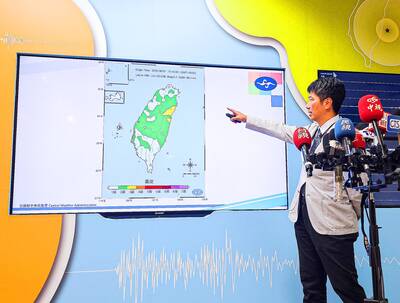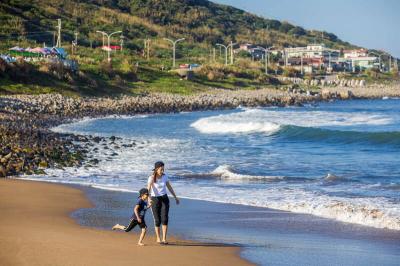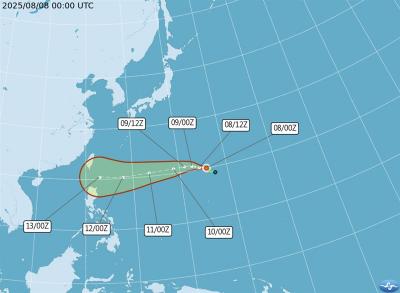Distrusting the government's recovery plan for devastated Aboriginal communities, an Aboriginal organization in Taitung yesterday drew up its own three-year plan and began asking for public donations.
“The government is not doing much to help Aborigines in Taitung rebuild their homes after several Aboriginal communities here were hit hard by Typhoon Morakot,” Sakinu Tepiq, a pastor at a Presbyterian Church in Taitung County's Taimali Township (太麻里), told the Taipei Times during a telephone interview.
“Even if the government does something, we're afraid that the relief efforts may not suit the needs of Aborigines,” he said.
For example, the government is considering building a collective housing project with prefabricated houses for residents who lost their homes.
“But Aborigines are not used to living in apartment complexes. Many of us own land, and we would prefer to rebuild our homes on our own land,” he said.
“Hence, we hope we can draw up our own recovery plan from a local perspective and with help from local organizations,” Sakinu said.
Sakinu and other local Aboriginal leaders have set up an organization — the Foundation for Reconstruction of Aboriginal Communities — to oversee the project.
The foundation's short-term goal is to provide psychological counseling to typhoon survivors, so they could return to normal life as soon as possible, Sakinu said.
As for children, after-school tutorials will be organized to help them catch up with schoolwork, with the new semester scheduled to begin at the end of the month.
“We will need about 50 to 60 teachers, and we hope young people working in cities could return to their home villages to take these jobs,” Sakinu said, adding that similar care programs would also be created for the elderly.
The next step is to secure a source of income for storm survivors.
Sakinu said the survivors could become farmers, while the foundation will try to establish channels to sell their produce.
The foundation will also talk to the government about allowing locals to use wood washed down by the raging waters onto beaches or into harbors nearby to make handicrafts, sculpture or furniture.
“If it works out, we will sell the work for reconstruction funds,” Sakinu said.
While Aboriginal typhoon survivors in Taitung have already mapped out their plans, more than 1,000 Aboriginal residents from Kaohsiung County's Namasiya Township, who were evacuated from their homes and have been living in shelters at the Buddhist Fo Guang Shan Monastery, are still uncertain about theirs.
“We're not sure when we will be able to move out of the shelter into our next residence — not to mention returning to our homes in Namasiya,” said Yeh Yi-hsuan (葉一萱), a teacher from Namasiya's Sanmin Junior High School. “The government could give us subsidies for rent, or move us into prefabricated houses — it's been more than 10 days and we still don't know what will happen.”
If they are to move into prefabricated houses, it will take the government sometime to search for a suitable location first and another month to build these houses, she said.
Besides thinking of the future, Namasiya residents also have other problems.
While the Buddhist monks and nuns at the monastery treat them well, the predominantly Christian Aborigines are not used to Buddhist culture.
“They serve only vegetarian food here, which many people are not used to,” Yeh said. “Fortunately, the clergy at the monastery is nice enough to hire a catering service to cook non-vegetarian for us outside of the monastery every two days or so.”
Another challenge to the survivors includes schooling for students living in shelters. Fortunately, several schools in Kaohsiung have agreed to allow students and teachers from Namasiya to use their idle classrooms once school starts.
“But that means parents may have to be separated from their children,” Yeh said.

Aftershocks from a magnitude 6.2 earthquake that struck off Yilan County at 3:45pm yesterday could reach a magnitude of 5 to 5.5, the Central Weather Administration (CWA) said. Seismological Center technical officer Chiu Chun-ta (邱俊達) told a news conference that the epicenter of the temblor was more than 100km from Taiwan. Although predicted to measure between magnitude 5 and 5.5, the aftershocks would reach an intensity of 1 on Taiwan’s 7-tier scale, which gauges the actual effect of an earthquake, he said. The earthquake lasted longer in Taipei because the city is in a basin, he said. The quake’s epicenter was about 128.9km east-southeast

GENSLER SURVEY: ‘Economic infrastructure is not enough. A city needs to inspire pride, offer moments of joy and foster a sense of belonging,’ the company said Taipei was named the city with the “highest staying power” in the world by US-based design and architecture firm Gensler. The Taiwanese capital earned the top spot among 65 cities across six continents with 64 percent of Taipei respondents in a survey of 33,000 people saying they wanted to stay in the city. Rounding out the top five were Vietnam’s Ho Chi Minh City (61 percent), Singapore (59 percent), Sydney (58 percent) and Berlin (51 percent). Sixth to 10th place went to Monterrey, Mexico; Munich, Germany; Sao Paulo, Brazil; Vancouver; and Seoul. Cities in the US were ranked separately, with Minneapolis first at

The New Taipei City Government today warned about the often-overlooked dangers of playing in water, and recommended safe swimming destinations to cool off from the summer heat. The following locations in the city as safe and fun for those looking to enjoy the water: Chienshuiwan (淺水灣), Baishawan (白沙灣), Jhongjiao Bay (中角灣), Fulong Beach Resort (福隆海水浴場) and Sansia District’s (三峽) Dabao River (大豹溪), New Taipei City Tourism and Travel Department Director-General Yang Tsung-min (楊宗珉) said. Outdoor bodies of water have variables outside of human control, such as changing currents, differing elevations and environmental hazards, all of which can lead to accidents, Yang said. Sudden

Tropical Storm Podul has formed over waters north-northeast of Guam and is expected to approach the seas southeast of Taiwan next week, the Central Weather Administration (CWA) said today. The 11th Pacific storm of the year developed at 2am over waters about 2,660km east of Oluanpi (歐鑾鼻), Pingtung County — Taiwan's southernmost tip. It is projected to move westward and could have its most significant impact on Taiwan on Wednesday and Thursday next week, the CWA said. The agency did not rule out the possibility of issuing a sea warning at that time. According to the CWA's latest update, Podul is drifting west-northwest